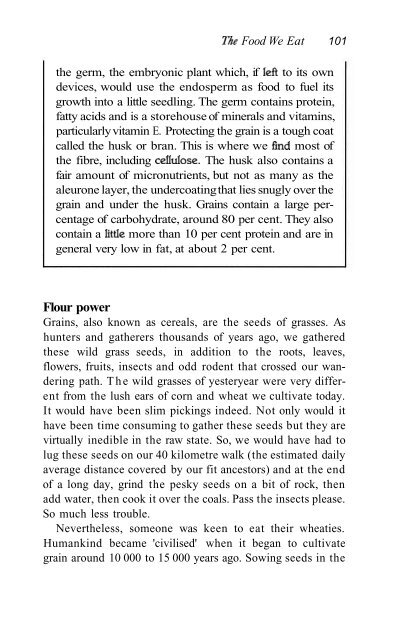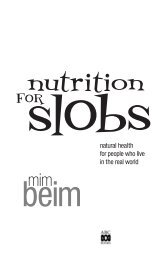Eating Well - Beaming with Health
Eating Well - Beaming with Health
Eating Well - Beaming with Health
Create successful ePaper yourself
Turn your PDF publications into a flip-book with our unique Google optimized e-Paper software.
TAe Food We Eat 101<br />
the germ, the embryonic plant which, if lefi to its own<br />
devices, would use the endosperm as food to fuel its<br />
growth into a little seedling. The germ contains protein,<br />
fatty acids and is a storehouse of minerals and vitamins,<br />
particularly vitamin E. Protecting the grain is a tough coat<br />
called the husk or bran. This is where we frnd most of<br />
the fibre, including celIulose. The husk also contains a<br />
fair amount of micronutrients, but not as many as the<br />
aleurone layer, the undercoating that lies snugly over the<br />
grain and under the husk. Grains contain a large percentage<br />
of carbohydrate, around 80 per cent. They also<br />
contain a little more than 10 per cent protein and are in<br />
general very low in fat, at about 2 per cent.<br />
Flour power<br />
Grains, also known as cereals, are the seeds of grasses. As<br />
hunters and gatherers thousands of years ago, we gathered<br />
these wild grass seeds, in addition to the roots, leaves,<br />
flowers, fruits, insects and odd rodent that crossed our wandering<br />
path. The wild grasses of yesteryear were very different<br />
from the lush ears of corn and wheat we cultivate today.<br />
It would have been slim pickings indeed. Not only would it<br />
have been time consuming to gather these seeds but they are<br />
virtually inedible in the raw state. So, we would have had to<br />
lug these seeds on our 40 kilometre walk (the estimated daily<br />
average distance covered by our fit ancestors) and at the end<br />
of a long day, grind the pesky seeds on a bit of rock, then<br />
add water, then cook it over the coals. Pass the insects please.<br />
So much less trouble.<br />
Nevertheless, someone was keen to eat their wheaties.<br />
Humankind became 'civilised' when it began to cultivate<br />
grain around 10 000 to 15 000 years ago. Sowing seeds in the



